Today the Moscow Sretensky Stravropegic Monastery celebrated twenty years since the rebirth of monastic life within its walls. The first monastic service, led by the newly-appointed abbot of the monastery, Fr. Tikhon (Shevkunov), took place on the eve of the feast of the Meeting of the Lord, February 14, 1994.
This ancient monastery is dedicated to an event in Russian history that became a milestone in the nation’s survival and formation—the meeting, in Russian sretenie, of Holy Hierarch Cyprian and other Muscovites with the Vladimir icon of the Mother of God in 1395. Brought in a religious procession from the city of Vladimir, the miracle-working icon would remain in Moscow. Through the intercessions of the Mother of God, at the moment of this meeting the invader Tamerlane turned back, sparing the city of Moscow from his ravaging.
Because the monastery is named after this “meeting”, people often think that it is dedicated to the Meeting of the Lord. This is a mistake, but not entirely. The feast of the Meeting of the Lord in fact turned out to be the day of the monastery’s rebirth after soviet repression and neglect, in 1994.
In 1993, Hieromonk Tikhon (now an Archimandrite) received a blessing from his spiritual father, elder of the Pskov-Caves Monastery Archimandrite John (Krestiankin), to approach His Holiness Patriarch Alexy II with a request to start a metochion—or representation—of the Pskov-Caves Monastery in Moscow. The Pkov-Caves Monastery is located in Pskov Province, near the Estonian border. Although the Patriarch was not permitting any provincial monasteries to open representations in the Russian capital at that time, to Fr. Tikhon’s great surprise he readily granted permission for this project. Fr. Tikhon recalls his initial terror: “Trembling with fear, I uttered the phrase I had carefully studied so that I wouldn’t mix things up: ‘Your Holiness, bless me to transfer to the Pskov-Caves Monastery and found its metochion in Moscow.’ I stammered out the words, and then froze in horror. But out of nowhere, His Holiness the Patriarch said, ‘Fr. Tikhon! That is very good. Yes, yes, yes—it’s quite needed, really, quite needed.’”
Estonia had only recently declared its independence from the former Soviet Union, and many thought that the border zone would soon be closed, cutting off access to Russia’s beloved Pskov-Caves Monastery. In order to retain a connection, an affiliate of the monastery would be needed in Moscow. The Patriarch had only recently been mulling over the consequences of these political changes, and therefore Fr. Tikhon’s request came at just the right moment.
Fr. John (Krestiankin) gave Fr. Tikhon specific instructions about how to pick the metochion’s location: “Do not take the first, big one. Take the small one.” The diocese presented two different locations, which Fr. Tikhon declined, saying they were too large or grandiose. The third location was the ancient Sretensky Monastery, located near the heart of Moscow. From a monastic point of view, the choice was illogical. Of all its pre-revolutionary buildings only one church remained, and it was in pitiful condition. The entrance is from Lubyanka Street—notorious for its preponderance of KGB offices and underground prisons. Music blares from bars across the street, and traffic snarls along the cross streets bordering the monastery territory. Nevertheless, the famous elder of the Pskov-Caves enthusiastically blessed Fr. Tikhon to accept the offer and take up residence in the ruins of a once glorious monastic community.
But there was another hurdle to overcome. The church was already in use by another priest, Fr. Georgy Kochetkov. Fr. Kochetkov is a controversial figure in the Russian Orthodox Church. He is known for his self-willed renovations in Church liturgical practice, and an unapproved catechism he wrote, introducing heretical ideas. He has a following that looks very much like a sect, and when the diocese ordered him to release the premises to Fr. Tikhon, Fr. Georgy and his followers refused to do so.
 Svetlana Ivleva. First service in the restored Sretensky Monastery.
Svetlana Ivleva. First service in the restored Sretensky Monastery.
Undaunted and determined to carry out the Patriarch’s directive, Fr. Tikhon and a group of parishioners came to the Church of the Vladimir Icon of the Mother of God at Sretensky Monastery on the eve of the feast of the Meeting of the Lord in 2014, intending to serve the Vigil for the feast within its walls. He was greeted by a locked door—Fr. Georgy and his followers were inside, and would not let anyone else in. Undeterred, Fr. Tikhon set up outside the church, and began the All-Night Vigil for the Meeting of the Lord.
Today, in 2014, the temperature outside is +3 degrees Celsius. But on that evening in 1994, it was a biting -25. Perhaps that helped fix the memory of this first monastic service since 1925 in the hearts and minds of that small, intrepid group. Fr. Tikhon was soon able to begin monastic life on this sacred and historical site, and after the threat of losing the Pskov-Caves monastery to Estonia had passed, Sretenksy became an independent monastic community. It is called “stavropegic”, which means that it is directly under the authority of the Patriarch, rather than the local bishop.
Looking at the Sretensky Monastery today, it is hard to imagine how it appeared back then. In place of the delicate landscaping with climbing grape vines, flowering bushes, graceful trees, and a babbling fish pond, there was refuse, torn up walkways, and no wall to guard it from the outside world. Where the seminary now stands was a high school, and teenage students mingled and crossed paths with church-goers in the early morning hours. God has since abundantly blessed Fr. Tikhon’s and the brothers’ efforts, and the monastery now flourishes on numerous fronts. Its scope continues to grow: several years ago, Mayor Luzhkov granted several buildings, including the high school, to the monastery, and officially expanded its territory. Now the ground is being prepared for the construction of a new, large church dedicated to the New Martyrs of Russia. After all, this very ground was soaked in the blood of Orthodox Christians who died for their faith during the early years of communist-atheist rule.
As the years pass, Fr. Tikhon’s reservoir of amazing but true stories swells ever deeper and wider. The famous collection of the former cinematographer’s reminiscences, the book entitled Everyday Saints and Other Stories, overflowed this reservoir’s banks, selling over a million copies in only one year after its release. One story that did not make it into that spiritual blockbuster was recently posted on the monastery website, Pravoslavie.ru, in a series leading up to the twentieth anniversary. It is the story of Evgenia Matfeyevna Grika, who died on February 9 of this year. As a notable exception to the monastery rule, this parishioner’s funeral service was held in the monastery church, and served by the abbot himself.
What made this woman so deserving of this particular honor? Archimandrite Tikhon told her story in the sermon he gave at the rite:
“Today we are burying Evgenia Matveyevna Grika, a poor widow, and the main benefactor of our monastery.
“When I was walking to the Liturgy early this morning, I was thinking that it would be most appropriate to cite in the homily before Evgenia’s funeral the Gospel about the widow and her two mites. I did not know that this would be the very passage appointed to be read during the Liturgy on this day. When I heard it being read during the Liturgy, I thought—that’s it. Knowing the details of Evgenia’s life, I felt that this was more than mere coincidence…
“Evgenia Matfeyevna Grika lived a truly long, wise, and joyful life. She was born in 1914, and was nearing her 100th year. She was a parishioner of Sretensky Monastery for twenty years.
“We are by no means exaggerating when we call Evgenia Matfeyevna the ‘main benefactor’ of this holy monastery. When at the blessing of His Holiness Patriarch Alexy in 1994, the monks came to Sretensky Monastery to revive there monastic life, we were met by Evgenia Matfeyevna. She was very tough. She greeted us with extremely unpleasant, odious words. The reason for this was her experience with the clergy who preceded us here.
“Evgenia Matveyevna was the owner of very large building on Bolshaya Lubyanka Street—where our refectory, kitchen, bookstore, and library are now located. The building belonged to the monastery before the revolution, and afterwards the Moscow government turned it over to various industrial workshops. When at the beginning of the 1990s the church was given to the first religious community, Evgenia Matfeyevna was drawn to help it with all her heart, and gave an entire floor of her property for its use. However… let’s just say that it didn’t work out. Evgenia Matfeyevna was deeply offended, and this extremely difficult relationship between her and them tainted her personal view of the entire Orthodox Church.
“But glory be to God, within a short time everything changed, and we became good friends. Later, a tragedy visited Evgenia’s life: her son Alexander was near death. This was the first time she turned to the Church for help. By God’s mercy, not long before Alexander’s death, she became conscience of herself as an Orthodox Christian and began to go to church. Alexander confessed and received Communion.
“Then, Evgenia Matfeyevna came one day and told me that she wanted to give the building she owned to the monastery. We knew very well that this was all she had, if you don’t count the tiny closet-like apartment where she lived on the outskirts of Moscow. We told her that we cannot accept such an expensive gift as thanks for our care over her son, which was in fact no more than our priestly duty. But Evgenia Matfeyevna taught the monks a real lesson, answering that she was giving her property not to us, but to God…
“Yes, it is no coincidence that today, the day we are serving the funeral rite for Evgenia Matfeyevna, we read the Gospel passage about the widow’s mite…”
Although Evgenia Matfeyevna Grika stands out as the monastery’s main benefactor, and her relationship with Sretensky Monastery became only warmer and closer over the years, she is by no means the only servant of God who unstintingly gave and still gives support to the monastery. There are many, many devoted benefactors from little to great. Through their help and love, the monastery has grown to what it is today, and continues to grow. And they feel the monks’ gratitude.
As a token of this gratitude, an anniversary concert was organized for lay workers and benefactors featuring the world famous Sretensky Monastery Choir. Today after the festal Liturgy, as the faithful left the church they were each handed a special spice cake, prepared for this occasion.
Happy anniversary!

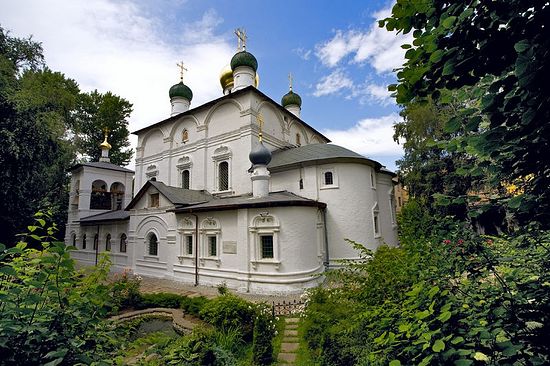
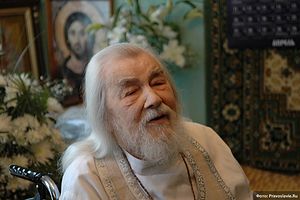
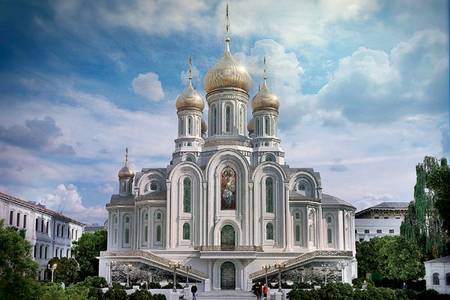


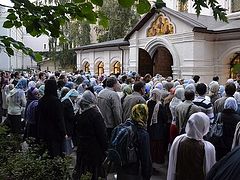




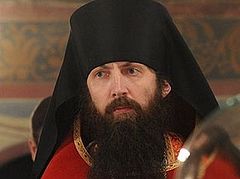
Sincerely,
Reader Tikhon, San Francisco